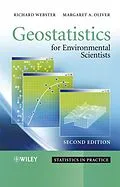Geostatistics is essential for environmental scientists. Weather
and climate vary from place to place, soil varies at every scale at
which it is examined, and even man-made attributes - such as
the distribution of pollution - vary. The techniques used in
geostatistics are ideally suited to the needs of environmental
scientists, who use them to make the best of sparse data for
prediction, and top plan future surveys when resources are limited.
Geostatistical technology has advanced much in the last few
years and many of these developments are being incorporated into
the practitioner's repertoire. This second edition describes
these techniques for environmental scientists. Topics such as
stochastic simulation, sampling, data screening, spatial
covariances, the variogram and its modeling, and spatial prediction
by kriging are described in rich detail. At each stage the
underlying theory is fully explained, and the rationale behind the
choices given, allowing the reader to appreciate the assumptions
and constraints involved.
Autorentext
Richard Webster, Rothamsted Research, Harpenden
Dr Webster is the Senior Research Fellow at Rothamsted Research.
Margaret A. Oliver, Visiting Professor, Department of Soil Science, University of Reading
Professor Oliver has taught geostatistics, applied statistics, multivariate analysis and pedology to undergraduates and postgraduates. She also established a short geostatistics course while at the University of Birmingham, which has now been taught in several countries (e.g. Sweden, USA and Mexico). She is the author of over 70 papers and two co-authored books.
Klappentext
There are many factors that environmental scientists should consider in their research. Weather and climate vary widely between locations, soil varies at every spatial scale at which it is examined, and even man-made attributes, such as the distribution of pollution, fluctuate significantly. To analyse the varied kinds of data and to predict at unvisited places from them, research scientists need to be familiar with the techniques of Geostatistics.
This revised and fully updated second edition of Geostatistics for Environmental Scientists provides comprehensive coverage of the techniques involved in this vital branch of statistics. The book
- introduces readers to the most up-to-date statistical techniques, including, sampling, data screening, spatial covariances, the variogram and its modelling;
- includes a new chapter on stochastic simulation, and covers the latest methods, such as residual maximum likelihood and factorial kriging analysis;
- adopts a practical approach throughout, illustrating the applications with worked examples and case studies;
- provides step-by-step guidance for analysing environmental survey data;
- explains the underlying theory and rationale behind the choices faced by the researchers at each stage, allowing the reader to appreciate the assumptions and constraints involved.
The accessible style of Geostatistics for Environmental Scientists, Second Edition makes this text invaluable to advanced undergraduate and graduate students of spatial variation and environmental research.
Zusammenfassung
Geostatistics is essential for environmental scientists. Weather and climate vary from place to place, soil varies at every scale at which it is examined, and even man-made attributes such as the distribution of pollution vary. The techniques used in geostatistics are ideally suited to the needs of environmental scientists, who use them to make the best of sparse data for prediction, and top plan future surveys when resources are limited.
Geostatistical technology has advanced much in the last few years and many of these developments are being incorporated into the practitioner's repertoire. This second edition describes these techniques for environmental scientists. Topics such as stochastic simulation, sampling, data screening, spatial covariances, the variogram and its modeling, and spatial prediction by kriging are described in rich detail. At each stage the underlying theory is fully explained, and the rationale behind the choices given, allowing the reader to appreciate the assumptions and constraints involved.
Inhalt
Preface
1 Introduction
2 Basic Statistics
3 Prediction and Interpolation
4 Characterizing Spatial Processes: The Covariance and Variogram
5 Modelling the Variogram
6 Reliability of the Experimental Variogram and Nested Sampling
7 Spectral Analysis
8 Local Estimation or Prediction: Kriging
9 Kriging in the Presence of Trend and Factorial Kriging
10 Cross-Correlation, Coregionalization and Cokriging
11 Disjunctive Kriging
12 Stochastic Simulation (new file)
Appendix A
Appendix B
References
Index
